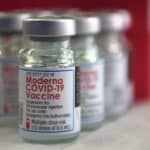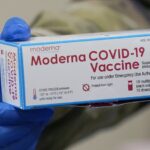Edward Dowd called out mRNA excess deaths from Covid mRNA injections.
⁃ TN Editor
On July 2, 2024, the U.S. government awarded a $176 million contract to Moderna, Inc. for the development of an mRNA H5N1 avian influenza biologic labeled a “vaccine,” as the media reports concerns about bird flu in dairy cows and farm workers in multiple states. The funds from the U.S. Biomedical Advanced Research and Development Authority (BARDA) will be used to finish developing and testing a pre-pandemic mRNA (messenger ribonucleic acid) biologic for H5N1 bird flu, pending the results of Phase 1 clinical trials, which are expected to be completed this month. Late-stage testing of the vaccine is set to begin in 2025.1
The first outbreak of the H5N1 avian influenza virus in dairy cattle was reported in March 2024, and the avian virus reportedly has since infected more than 130 cattle herds in 12 states.2 Bird flu, or avian influenza, is a virus that primarily infects birds but can sometimes infect other animals and, recently, has been reported to occasionally infect farm workers in contact with infected chickens or cattle. It spreads through direct contact with infected birds or their droppings, feathers, or saliva.3
According to the U.S. Centers for Disease Control and Prevention (CDC), poultry farmers or workers who handle birds or those who have contact with infected birds or contaminated environments are most at risk. Like with many viral infections, including SARS-CoV-2, infected individuals can have mild symptoms or no symptoms at all. According to the CDC, the most common symptoms in those affected with bird flu include pink eye (conjunctivitis), fever, sore throat and cough, with pneumonia being a serious complication.3
Warnings That Human-to-Human Transmission Could Happen
Public health officials are stepping up increased surveillance, which began in 2020 as virologists monitored a new muitated H5N1 avian flu subtype in migratory birds. Now that the new bird flu virus has spread to 129 dairy herds in 12 states in the country and infected various mammals, including alpacas and house cats, there are fears that the virus may be getting closer to widespread human-to-human transmission.4
“It almost seems like a pandemic unfolding in slow motion,” said Scott Hensley, PhD, professor of microbiology at the University of Pennsylvania. “Right now, the threat is pretty low… but that could change in a heartbeat.”4
While H5N1 is not currently transmissible between humans, other experts, including the former director of the CDC, Robert Redfield, MD, warn that could change. In a recent interview, Dr. Redfield, who led the health agency between 2018 and 2021, expressed grave concern over the growing number of human infections in the U.S., citing a bird flu pandemic as “imminent.”
Dr, Redfield discussed gain-of-function research conducted on H5N1 avian influenza in 2012 and how it would be easy “to make bird flu highly infectious for humans.” He stated:
I really do think it’s very likely that we will, at some time; it’s not a question of if, it’s more a question of when we will have a bird flu pandemic. I know exactly what amino acids I have to change because in 2012, against my recommendation, the scientists that did these experiments actually published them. So, the recipe for how to make bird flu highly infectious for humans is already out there.5
Moderna Contract Allows For “Accelerated Development”
Amid growing concern that exposure to the virus in poultry and dairy operations could increase the risk of mutation and transmissibility between humans, the $176 million contract between Moderna and the U.S. government allows for accelerated development should human cases and/or their severity continue to grow, similar to the framework of Operation Warp Speed, the COVID shot development initiative in 2020.1
Dawn O’Connell, the assistant secretary for preparedness and response at the U.S. Department of Health and Human Services (HHS), stated that the risk of bird flu to the general public remains low, so vaccination is not currently recommended. However, Nirav Shah, MD, MPH, principal deputy director of the CDC, mentioned that government agencies are having “robust discussions” about the potential benefits of vaccinating farm workers, although no definitive guidance has been given.1
The CDC, along with the U.S. Department of Agriculture (USDA) and state and local health departments across the country, stated that they have been preparing for the emergence of a new influenza virus for nearly two decades and continuously monitor for any changes in the virus.4
The government, which is also in negotiations with Pfizer, Inc. about developing a new H5N1 mRNA biologic—expects to have more announcements on bird flu vaccines in the near future, O’Connell said.1










